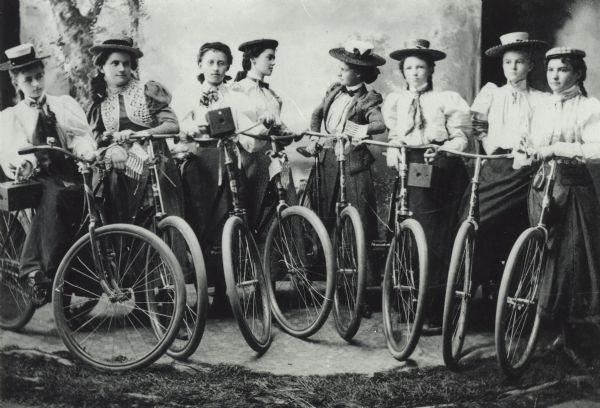In the above image, eight young women pose with their bicycles in a photography studio in Tomahawk in 1900. Bicycling changed many parts of American culture but for women, it was more than just fun: bikes offered freedom and empowerment.
In the 19th century, bicycles became emblematic of women’s bid for freedom and self-determination. Riding a bicycle gave women new mobility and challenged Victorian restrictions on female behavior. A woman on a bicycle no longer needed to depend on a man for transportation. She could come and go as she pleased. Enthusiasm for biking and women’s rights became so entwined that famed woman’s rights leader Susan B. Anthony once said that the bicycle “has done more to emancipate women than anything else in the world.”
Many women in Wisconsin, like women all over the country, took to the bike immediately. Edith Shuler demonstrated an early bicycle model known as the velocipede in Milwaukee through the spring of 1869, becoming an early ambassador for the sport.
Stay informed on the latest news
Sign up for WPR’s email newsletter.
Wisconsin-raised Frances Willard, leader of the Women’s Christian Temperance Union, even published a book about her efforts to learn to ride a bike in her fifties. It took her about three months of daily practice to conquer “this most mysterious animal.” It was a process of mastery that that Willard used as a metaphor for women’s mastery of their own lives. Her enthusiasm for the bicycle inspired other women to pick up the sport.
“To men, the bicycle in the beginning was merely a new toy, another machine added to the long list of devices they knew in their work and play. To women, it was a steed upon which they rode into a new world,” proclaimed Munsey’s Magazine in 1896.
All kinds of claims were made to discourage women from taking to the bike. Some critics warned that the bicycle would harm women’s health. The sensitivity and fragility of women was a common theme. Women’s magazines often featured doctors warning of the dangers the bike posed to women’s reproductive organs. Others said the bicycle would get young women into trouble by allowing them to stray further from watching eyes during courtship. A woman on a bike was a threat to the social order.
It wasn’t just men who felt this way. Charlotte Smith, an outspoken advocate for women in other issues, called the bicycle “the devil’s advance agent morally and physically” in 1896.
The freedom that many women found on the bike took many forms, not the least of which was clothing. The restrictive corsets and long skirts that women wore were not exactly conducive to pedaling. Cycling required a more practical form of clothing. “A woman with (bustle) bands hanging on her hips, and dress snug about the waist and chokingly tight at the throat, with heavy trimmed skirts dragging down the back and numerous folds heating the lower part of the spine, and with tight shoes, ought to be in agony,” wrote Willard in her book.
Those women that did adopt a new outfit, often loose fitting trousers known as bloomers, earned the scorn and mockery of cartoonists and critics who viewed a woman in pants as unfeminine and scandalous.
The controversy seemed only to spur women’s interest in the bicycle. And once women started riding, they never stopped.
Wisconsin Public Radio, © Copyright 2024, Board of Regents of the University of Wisconsin System and Wisconsin Educational Communications Board.


